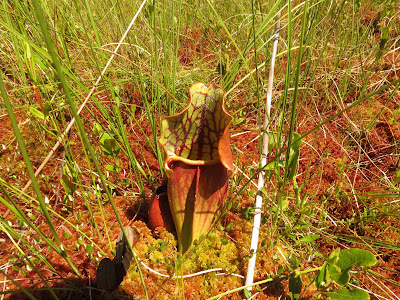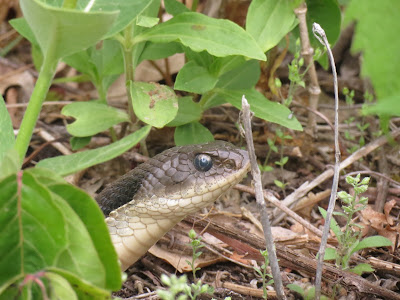One of the most sought-after groups of plants in Ontario (and all over the world) is the orchids. They are highly diverse, many species are strikingly beautiful, and many are very hard to find.
The Bruce Peninsula is perhaps the best place in North America for seeing orchids, with 54 recorded species (although quite a few of these have only been seen a handful of times). As such, one of our main goals on visiting the Bruce last weekend was to find a nice variety. Orchids bloom at staggered intervals throughout the summer, and our visit was a bit earlier than would be ideal, but we still managed to find four species as complete beginners at the task of orchid hunting.
I'm going to cheat a litte here and add a fifth species. Although Showy Orchis is found on the Bruce Peninsula, we didn't see any, and this photo comes from Rondeau in May. Showy Orchis is a species found scattered in rich deciduous forest.
The well-named Yellow Lady's Slipper is abundant on the Bruce Peninsula. Two varieties are found here: a larger one in drier open areas and a smaller one in shadier wet spots. Both are common and line the roadsides and trails in some locations.
Three other species of Lady's Slipper Grow locally but we were only able to find one. Luckily, it was the best of the bunch - the tiny and exquisite Ram's Head Lady's Slipper. This species is rare throughout its northeastern North American range.
Like all orchids, these Lady's Slippers produce huge numbers of miniscule seeds. Most will never germinate as they require an association with a fungus to provide the energy to get started. For the same reason, orchids are very difficult to cultivate.
Size comparison with Yellow Lady's Slipper
A variety of coralroots can be found on the Bruce Peninsula, with the most common at this time of year being the Striped Coralroot. Most coralroots have no leaves or chlorophyll, and obtain all their energy from associations with underground fungi.
Although our final species of orchid doesn't bloom until late summer, it has easily recognized leaves. Menzies' Rattlesnake-Plantain has dark evergreen leaves with a pale stripe down the middle. Note the brown spike of seed capsules from last year. Any given plant will not flower in most years, and of the dozens of individuals we saw only one had retained seed capsules.
Much of the information in this post came from the book
The Orchids of Bruce and Grey published by by the Owen Sound Field Naturalists. Despite the limited geographical scope, this slim guide is a great resource.



























